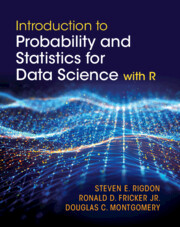Refine search
Actions for selected content:
48569 results in Computer Science
Essential covers of the hypercube require many hyperplanes
- Part of
-
- Journal:
- Combinatorics, Probability and Computing / Volume 34 / Issue 3 / May 2025
- Published online by Cambridge University Press:
- 16 December 2024, pp. 326-337
-
- Article
- Export citation

Algorithmic Rule By Law
- How Algorithmic Regulation in the Public Sector Erodes the Rule of Law
-
- Published online:
- 14 December 2024
- Print publication:
- 12 December 2024
-
- Book
-
- You have access
- Open access
- Export citation

Introduction to Probability and Statistics for Data Science
- with R
-
- Published online:
- 13 December 2024
- Print publication:
- 14 November 2024
-
- Textbook
- Export citation
SATISFACTION CLASSES WITH APPROXIMATE DISJUNCTIVE CORRECTNESS
- Part of
-
- Journal:
- The Review of Symbolic Logic / Volume 18 / Issue 2 / June 2025
- Published online by Cambridge University Press:
- 13 December 2024, pp. 545-562
- Print publication:
- June 2025
-
- Article
- Export citation
The transfer learning of uncertainty quantification for industrial plant fault diagnosis system design
-
- Journal:
- Data-Centric Engineering / Volume 5 / 2024
- Published online by Cambridge University Press:
- 13 December 2024, e41
-
- Article
-
- You have access
- Open access
- HTML
- Export citation
Enhancing resilience in IoT cybersecurity: the roles of obfuscation and diversification techniques for improving the multilayered cybersecurity of IoT systems
-
- Journal:
- Data & Policy / Volume 6 / 2024
- Published online by Cambridge University Press:
- 13 December 2024, e74
-
- Article
-
- You have access
- Open access
- HTML
- Export citation
Estimating the seasonal performance and electricity consumption of retrofitted heat pumps
- Part of
-
- Journal:
- Data-Centric Engineering / Volume 5 / 2024
- Published online by Cambridge University Press:
- 13 December 2024, e39
-
- Article
-
- You have access
- Open access
- HTML
- Export citation
Tree universality in positional games
- Part of
-
- Journal:
- Combinatorics, Probability and Computing / Volume 34 / Issue 3 / May 2025
- Published online by Cambridge University Press:
- 13 December 2024, pp. 338-358
-
- Article
- Export citation
QuantiVA: quantitative verification of autonomous driving
-
- Journal:
- Research Directions: Cyber-Physical Systems / Volume 3 / 2025
- Published online by Cambridge University Press:
- 13 December 2024, e1
-
- Article
-
- You have access
- Open access
- HTML
- Export citation
Transfer learning for predicting source terms of principal component transport in chemically reactive flow
-
- Journal:
- Data-Centric Engineering / Volume 5 / 2024
- Published online by Cambridge University Press:
- 13 December 2024, e42
-
- Article
-
- You have access
- Open access
- HTML
- Export citation
Index
-
- Book:
- Algorithmic Rule By Law
- Published online:
- 14 December 2024
- Print publication:
- 12 December 2024, pp 345-356
-
- Chapter
-
- You have access
- Open access
- HTML
- Export citation
2 - Algorithmic Regulation
-
- Book:
- Algorithmic Rule By Law
- Published online:
- 14 December 2024
- Print publication:
- 12 December 2024, pp 26-94
-
- Chapter
-
- You have access
- Open access
- HTML
- Export citation
6 - Conclusions
-
- Book:
- Algorithmic Rule By Law
- Published online:
- 14 December 2024
- Print publication:
- 12 December 2024, pp 297-310
-
- Chapter
-
- You have access
- Open access
- HTML
- Export citation
1 - Introduction
-
- Book:
- Algorithmic Rule By Law
- Published online:
- 14 December 2024
- Print publication:
- 12 December 2024, pp 1-25
-
- Chapter
-
- You have access
- Open access
- HTML
- Export citation
4 - From Rule of Law to Algorithmic Rule by Law
-
- Book:
- Algorithmic Rule By Law
- Published online:
- 14 December 2024
- Print publication:
- 12 December 2024, pp 151-229
-
- Chapter
-
- You have access
- Open access
- HTML
- Export citation
Contents
-
- Book:
- Algorithmic Rule By Law
- Published online:
- 14 December 2024
- Print publication:
- 12 December 2024, pp v-vi
-
- Chapter
-
- You have access
- Open access
- HTML
- Export citation
Figures
-
- Book:
- Algorithmic Rule By Law
- Published online:
- 14 December 2024
- Print publication:
- 12 December 2024, pp xi-xii
-
- Chapter
-
- You have access
- Open access
- HTML
- Export citation
















